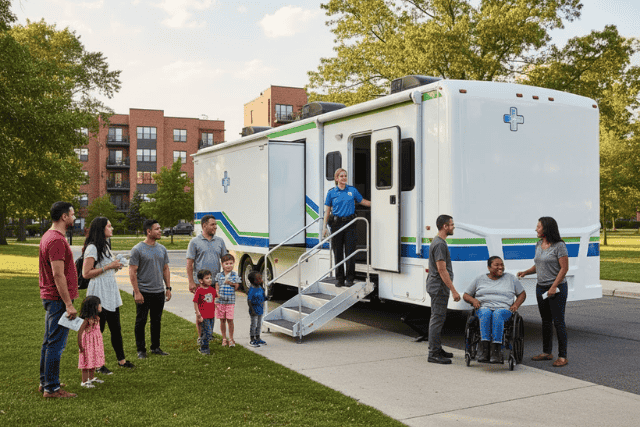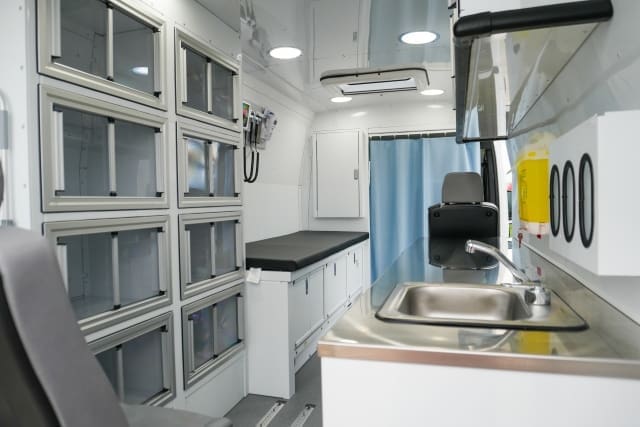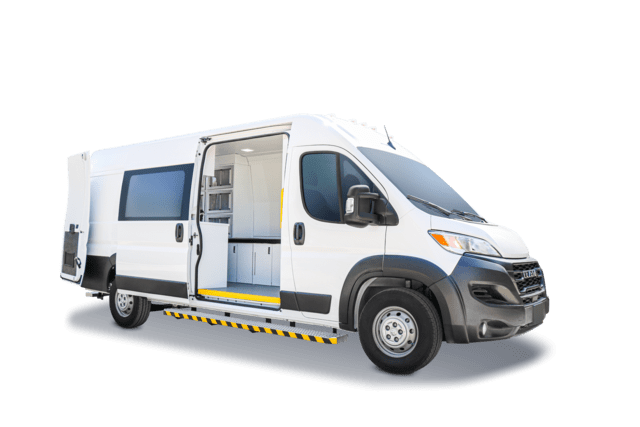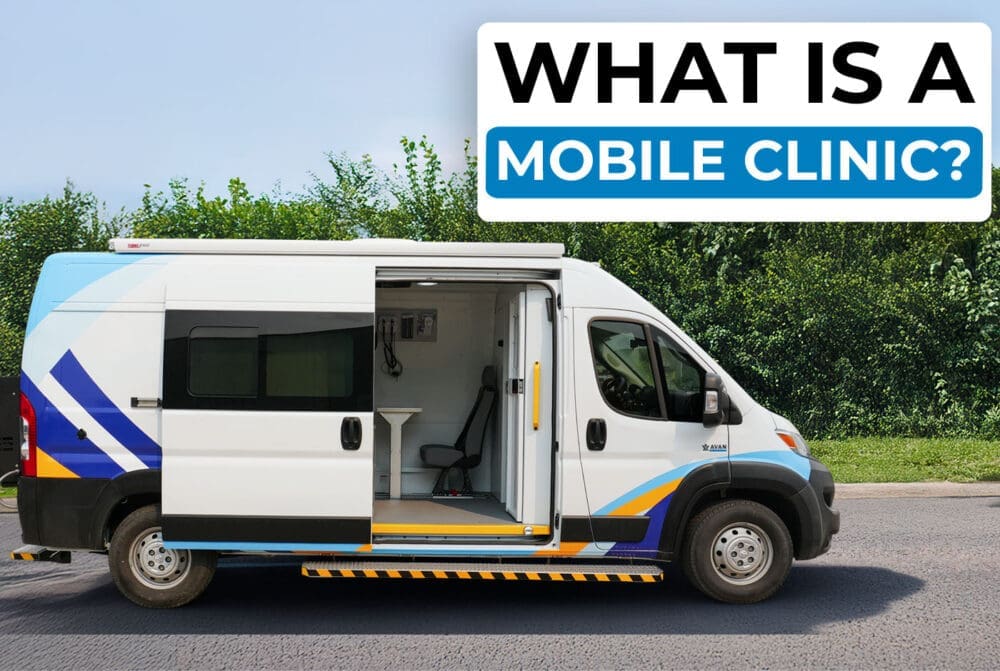New York is home to world-class hospitals, but that doesn’t mean healthcare is easy to access. Over 1.2 million New Yorkers live in areas without enough doctors. If your organization provides healthcare, you’ve likely seen this firsthand—patients missing care, long ER wait times, and not enough resources to go around.
That’s where a mobile clinic in New York can help. These units bring healthcare directly to people who need it, but buying the right one isn’t as simple as picking a van and hitting the road. The wrong choice can drain your budget, slow down operations, and leave your team struggling to deliver care effectively. The right one, though? It can transform your ability to reach underserved communities and improve health outcomes.
At AVAN Mobility, we build mobile medical units designed to remove healthcare barriers. For over 10 years, we’ve helped organizations like yours expand services with mobile health solutions. We’re not the only manufacturer out there, but we are experts in the field, and we want to help you make the best decision.
This guide will walk you through some key things to keep in mind when purchasing a mobile clinic in New York. We hope that by the time you’re finished reading, you’ll be equipped with a little more knowledge to make a more informed decision.
Is there a growing need for mobile clinics in New York?
About one in four adults in New York put off medical care because of cost or access problems. Some don’t have a doctor nearby, while others struggle with transportation. Many can’t take time off work or find childcare to make an appointment.
The result? People go without care until small health issues turn into big problems.
A mobile clinic in New York helps close that gap by bringing care directly to the people who need it. Instead of waiting for patients to come to a fixed healthcare center, you take healthcare to them—to neighborhoods, rural towns, and community hubs. This kind of outreach can lower ER visits, improve health outcomes, and make care more accessible for thousands of people.
Let’s take a look at a few important factors to think about to make sure your mobile medical unit fits your needs.
1. Look for the right size for your mobile clinic in New York
When you’re looking to buy a mobile clinic in New York, it’s easy to think that bigger is always better. A large unit can fit more equipment, staff, and patients, but bigger doesn’t always mean it’s the best option, especially in a city like New York.
Have you ever tried driving a bus or RV through NYC traffic? It’s no joke. With an average of 3.1 million vehicles clogging the streets daily, navigating a massive mobile clinic through tight spaces, narrow roads, and crowded intersections can be a challenge.
That’s why choosing the right size is about more than just space—it’s about how well your unit fits the areas you’ll serve.
Smaller mobile clinics work best if:
- You’ll be operating in high-traffic areas like Manhattan, Brooklyn, or the Bronx
- Parking and set-up space are limited
- You want lower maintenance costs and easier upkeep
- Your team doesn’t need multiple rooms for different services
Larger mobile clinics might be a good fit if:
- You need multiple exam rooms for different types of very specialized care
- You’ll mostly serve open areas like upstate New York or suburban communities
- You have the budget for higher fuel costs, maintenance, and staffing
- Your team is comfortable driving and parking a larger unit
The bottom line: The best size for your mobile medical unit in NY depends on where you’ll be operating, what services you’ll provide, and how much space you actually need. A massive unit might seem appealing, but if it’s hard to park, tough to maintain, and expensive to run, it could create more problems than it solves.
Before deciding, think about your daily operations, budget, and the locations you’ll serve.
2. Look for the right equipment and features for your mobile clinic
Once you know the right size for your mobile clinic in New York, the next big decision to think about is what equipment and features you need. A mobile clinic isn’t just a vehicle—it’s a fully functional healthcare space. The tools inside will depend on the type of care your organization provides.
Before making a decision, ask yourself: What services will we offer?
If your focus is on vaccines, you want:
- A vaccine refrigerator to keep doses at the right temperature
- Secure storage for syringes, alcohol wipes, and other supplies
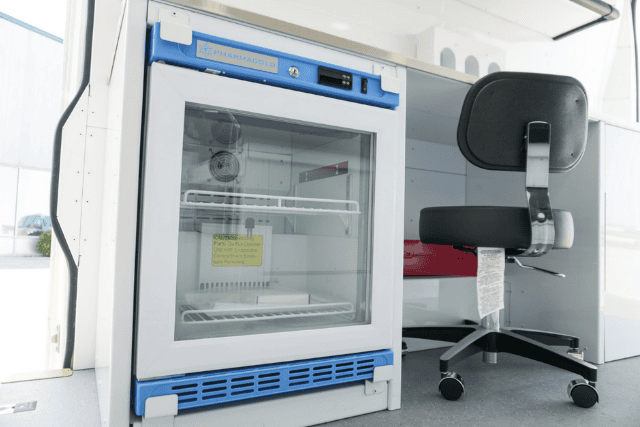
If you’re providing mobile primary care, you’ll want:
- Welch Allyn medical tools, including:
- Blood pressure monitors
- Thermometers
- Otoscopes and ophthalmoscopes
- Stethoscopes
- Exam bed for patient assessments
- Sink for proper hygiene
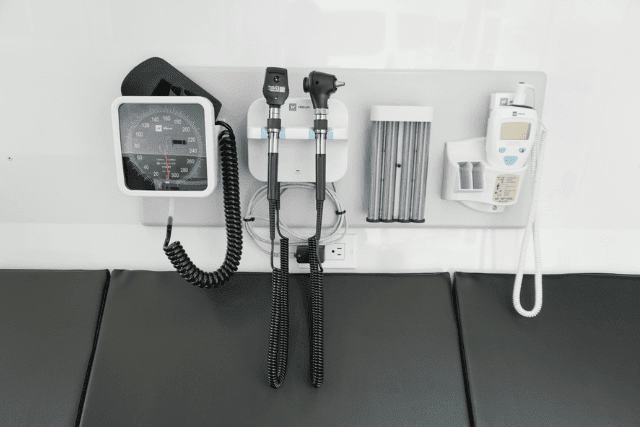
If you’re running a mobile dialysis program, you’ll want:
- Portable dialysis machine for on-the-go treatment
- Water filtration system for safe dialysis procedures
- Comfortable seating for patients during treatments
The bottom line: The right mobile clinic in NY needs the right tools for the job. Think about what your team needs to work efficiently, what will keep patients safe, and what equipment is required to meet medical regulations.
3. Look for the right price for your mobile clinic in New York
Buying a mobile clinic in New York is an investment, and like any big purchase, cost is a major factor. Your organization should make sure it fits within your short and long-term budgets.
At AVAN Mobility, our mobile clinics range between $170,000 to $290,000, depending on the level of customization. That price includes the essentials, but if you need specialized medical equipment, upgraded interiors, or additional features, costs can increase.
If you’re looking for an RV-style mobile clinic, expect to pay between $250,000 to 1,000,000+.
If your organization doesn’t have the full funds upfront, there are ways to make a mobile clinic more affordable:
Funding and grant opportunities to explore:
- State and federal grants for expanding healthcare access
- Nonprofit and foundation funding for mobile health programs
- Local government support for public health initiatives
- Private donations or fundraising efforts within your community
Many organizations partner with hospitals, universities, or public health departments to help share costs. It’s worth looking into different funding options before making a final decision.
The bottom line: A mobile health clinic in New York is a powerful tool for reaching more patients, but it needs to fit into your financial plan. If cost is a concern, exploring grants and funding early can help turn your mobile clinic from an idea into reality.
Need help looking for a mobile Clinic in New York?
You came to this article because your organization wants to expand healthcare access but maybe need some guidance on what to look for when deciding on the right mobile clinic in New York. You may have been unsure about what size is best, what equipment you need, or how to fit a mobile clinic into your budget. Now, you have a clearer understanding of what to look for.
Here’s what you learned:
Size: Bigger isn’t always better in New York traffic—choose a unit that fits your service area.
Equipment depends on your needs: From vaccine fridges to dialysis machines, picking the right tools makes all the difference.
Budget is key: Mobile clinics range in price, and funding options can help make them more affordable.
At AVAN Mobility, we work with organizations like yours and the Community Clinic of Southwest Missouri to design solutions that fit your exact needs. We’ve helped healthcare providers, nonprofits, and community outreach programs create mobile clinics that truly make an impact. We know this isn’t just a purchase—it’s a commitment to delivering better care, breaking down barriers, and saving lives.
If you have any questions, click the button below to talk to a mobility expert.
If you’re not ready yet, we have a few other resources that will help you learn more.
Be sure to read our five-part article series on mobile clinics. This might answer some more questions you have about them.
After that, check out the video below on the five pitfalls to avoid when purchasing a mobile clinic.


